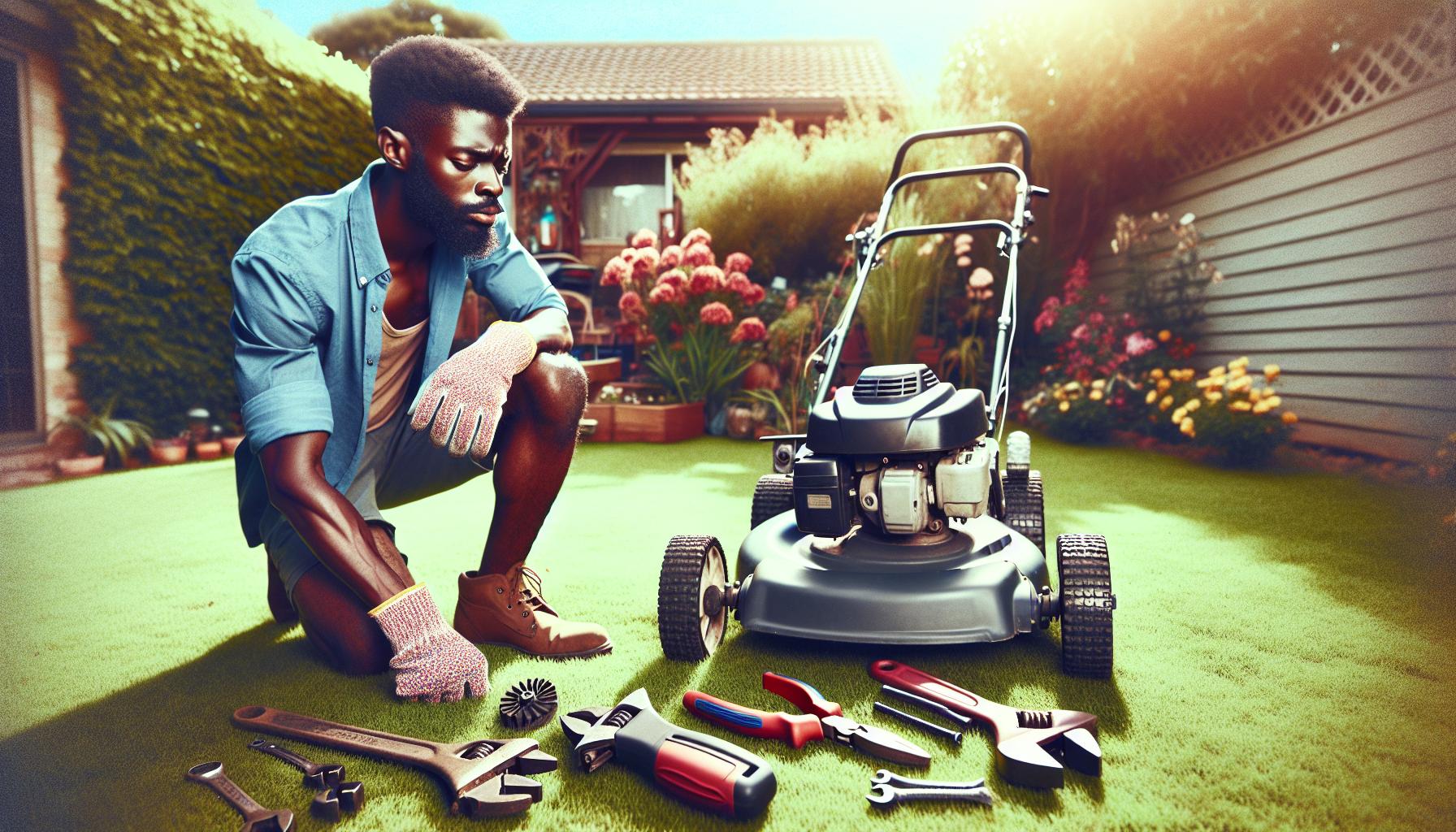A broken lawn mower wheel can turn a simple chore into a frustrating task. For innovative solutions, such as those offered by a Mowrator rc mower with advanced features, understanding wheel repair techniques is essential. This article walks through the steps and tools needed to restore functionality, ensuring you can maintain your lawn with ease.
Understanding Lawn Mower Wheels
Lawn mower wheels play a crucial role in the performance and manoeuvrability of the mower. Understanding their types and common issues can assist in effective maintenance and repairs.
Types of Lawn Mower Wheels
- Drive Wheels: Drive wheels move the mower forward and backward. Typically larger than other wheels, they often include a tread pattern for improved traction.
- Caster Wheels: Caster wheels allow for easier steering. These wheels pivot, helping navigate around obstacles while mowing.
- Front Wheels: Front wheels support the weight of the mower and provide stability. They may be fixed or swivel, depending on the mower design.
- Rear Wheels: Rear wheels offer additional support and traction. They’re crucial for manoeuvrability and generally assist in navigating uneven terrain.
Common Problems with Lawn Mower Wheels
- Flat Tyres: Flat tyres occur from punctures or air leaks. Regular inspection can prevent this issue.
- Worn Treads: Worn treads reduce traction, making mowing difficult. Replacing wheels when treads show significant wear is essential.
- Loose Bolts: Loose bolts can cause instability. Regularly checking and tightening bolts can enhance mower performance.
- Cracked Wheels: Cracked wheels often result from prolonged exposure to the elements or impact. Replacement is necessary if cracks are evident.
- Seized Bearings: Seized bearings hinder wheel rotation. Lubricating bearings regularly can prevent this common problem.
Understanding these aspects of lawn mower wheels aids in efficient garden maintenance and timely repairs.
Tools and Materials Needed

Repairing a broken lawn mower wheel requires specific tools and materials. Having these items ready simplifies the repair process and ensures effective results.
Essential Tools
- Wrench set: Use a wrench set to loosen and tighten bolts securely.
- Screwdriver set: A screwdriver set provides the variety of heads necessary for different screws on the mower.
- Pliers: Pliers help grip and manipulate small components as needed during the repair.
- Jack or lifting device: A jack or lifting device raises the mower, facilitating access to the wheels.
- Measuring tape: Measuring tape assists in accurately gauging wheel sizes for replacements.
- Rubber mallet: A rubber mallet helps in fitting wheels without damaging them.
Recommended Replacement Parts
- Wheel assembly: Replace the entire wheel assembly if repairs are inadequate or wear is significant.
- Tyres: Obtain tyres that match the original specifications for effective traction and performance.
- Bolts and hardware: Use new bolts and hardware to ensure strong connections and secure fittings.
- Bearings: Replace worn bearings to maintain smooth wheel rotation.
- Hub caps: Hub caps protect the wheel’s inner components from debris and moisture.
Having these tools and materials readily available streamlines the repair process, enhancing the maintenance of the lawn mower’s performance.
Step-by-Step Guide to Fixing a Broken Lawn Mower Wheel
Repairing a broken lawn mower wheel involves specific steps that ensure effective resolution of common issues.
Evaluating the Damage
Evaluating the damage requires a visual inspection of the wheel and its components. Look for cracks, flat tyres, or worn treads. Assess the wheel assembly for any bolts or hardware that might be loose or missing. Checking the bearings for signs of wear or corrosion is also crucial. Document all findings to determine whether repair or replacement is necessary.
Removing the Wheel
Removing the wheel involves several straightforward steps. First, raise the mower to access the wheel easily. Use a jack or lifting device for safety. Then, locate the securing bolts. With a wrench or socket set, remove these bolts. Carefully pull the wheel off the axle, being cautious of any attached components that may be displaced during the process.
Repairing or Replacing the Wheel
Repairing or replacing the wheel depends on the extent of the damage. If the tyre is flat, check for punctures and use a tyre repair kit if feasible. For cracked or broken components, replacement is likely necessary. Acquire the correct replacement parts, including complete wheel assemblies or specific components like bearings or hub caps. Reassemble the wheel by placing it back onto the axle and securing it with the bolts. Ensure everything is tightened correctly before lowering the mower back to the ground.
Maintenance Tips for Lawn Mower Wheels
Maintaining lawn mower wheels ensures optimal performance and extends the life of the equipment. Regular attention keeps mowing safe and effective.
Regular Inspections
Regular inspections of lawn mower wheels are vital for identifying issues early. Check for signs of wear, such as cracks in the wheel material or deformations. Examine the tyres for proper inflation and tread depth. Inspect the bolts and bearings for tightness and corrosion, ensuring they perform effectively. Conduct these inspections before each use and after every mowing session to prevent minor problems from escalating.
Cleaning and Lubrication
Cleaning and lubrication of lawn mower wheels enhance mobility and efficiency. Remove debris and grass clippings from around the wheels, particularly in the hub area. Use a mild detergent and water for cleaning; a brush can help remove stubborn dirt. After cleaning, apply a suitable lubricant to the bearings and axle to prevent rust and ensure smooth movement. This maintenance step reduces friction, promoting better performance and easier manoeuvrability. Regular lubrication should occur at least once per season or more frequently in harsh conditions.
Conclusion
Repairing a broken lawn mower wheel is a manageable task that can save both time and money. By understanding the specific issues and having the right tools on hand, anyone can restore their mower’s functionality. Regular maintenance is key to preventing future problems and ensuring the mower operates smoothly.
Taking the time to inspect and care for the wheels will enhance performance and extend the life of the equipment. With a little effort and knowledge, maintaining a well-kept lawn becomes an easier and more enjoyable task.
Frequently Asked Questions
What are the common issues with lawn mower wheels?
Common issues with lawn mower wheels include flat tyres, worn treads, loose bolts, cracked wheels, and seized bearings. Regular inspections can help identify these problems early, allowing for timely repairs and ensuring your mower operates efficiently.
How can I repair a broken lawn mower wheel?
To repair a broken lawn mower wheel, first assess the damage. Remove the wheel by lifting the mower, locating bolts, and pulling it off the axle. Depending on the issue, you can either repair or replace the wheel. Finally, reassemble by tightening all bolts securely.
What tools do I need to fix a lawn mower wheel?
You will need a wrench set, screwdriver set, pliers, a jack or lifting device, measuring tape, and a rubber mallet to fix a lawn mower wheel. Having these tools ready will make the repair process smoother and more efficient.
How often should I perform maintenance on my lawn mower wheels?
Regular maintenance should be conducted at least once every few months or before the mowing season starts. Checking for wear, ensuring proper tyre inflation, and inspecting bolts and bearings will extend the life of the mower and enhance its performance.
What replacement parts should I keep for mower wheel repairs?
It’s a good idea to keep wheel assemblies, tyres, bolts and hardware, bearings, and hub caps on hand. Having these replacement parts available ensures you can quickly fix any issues that arise and maintain optimal mower functionality.

